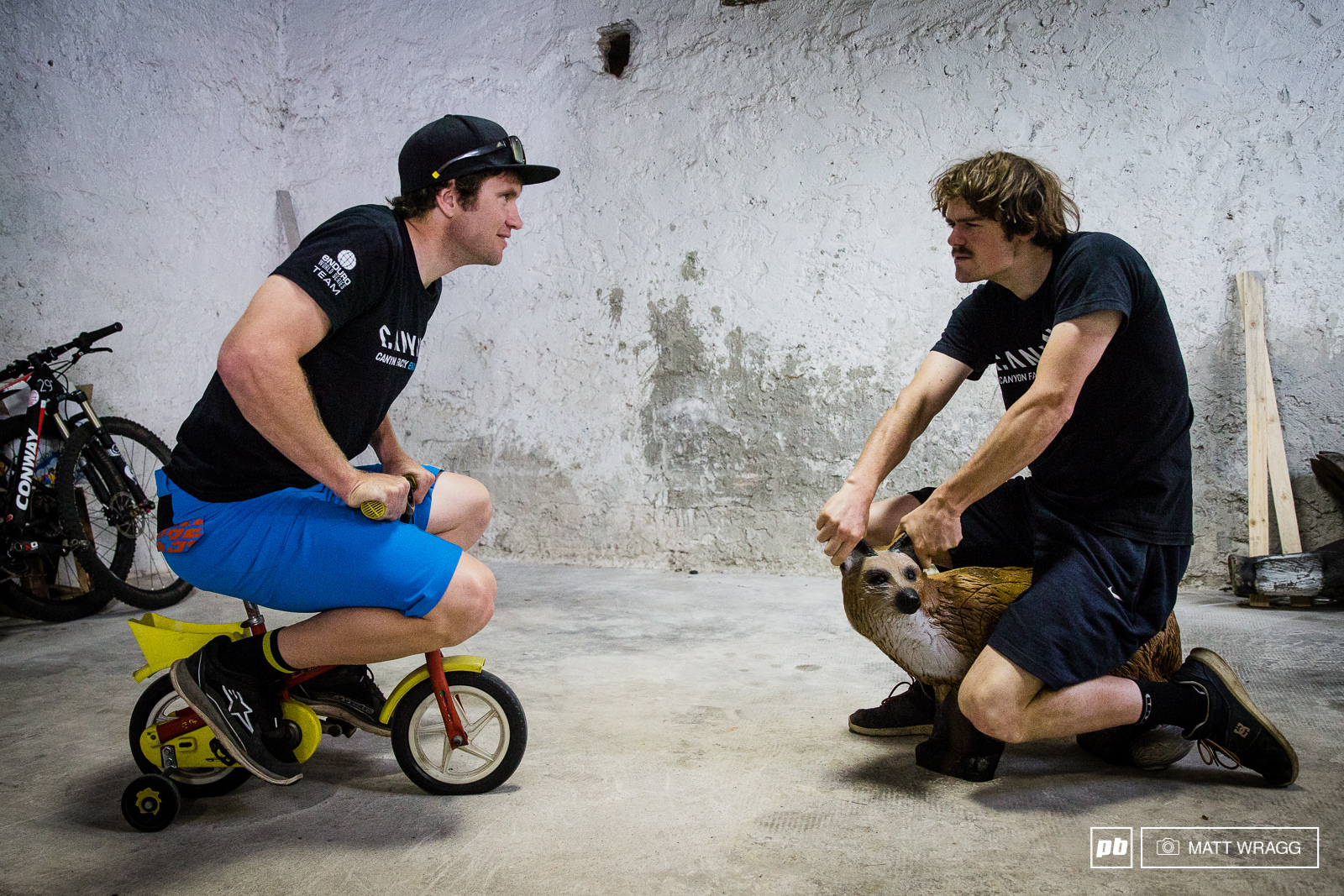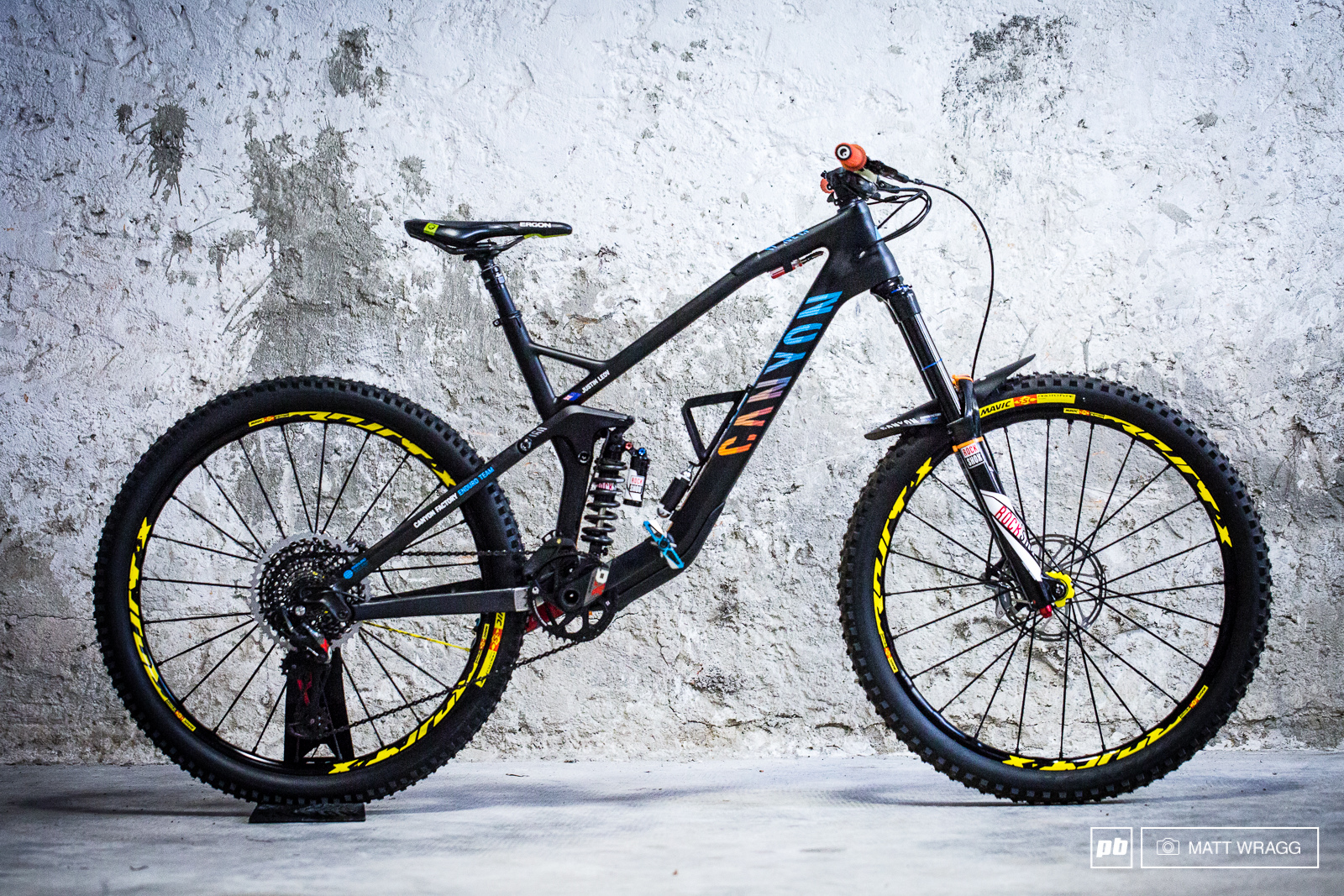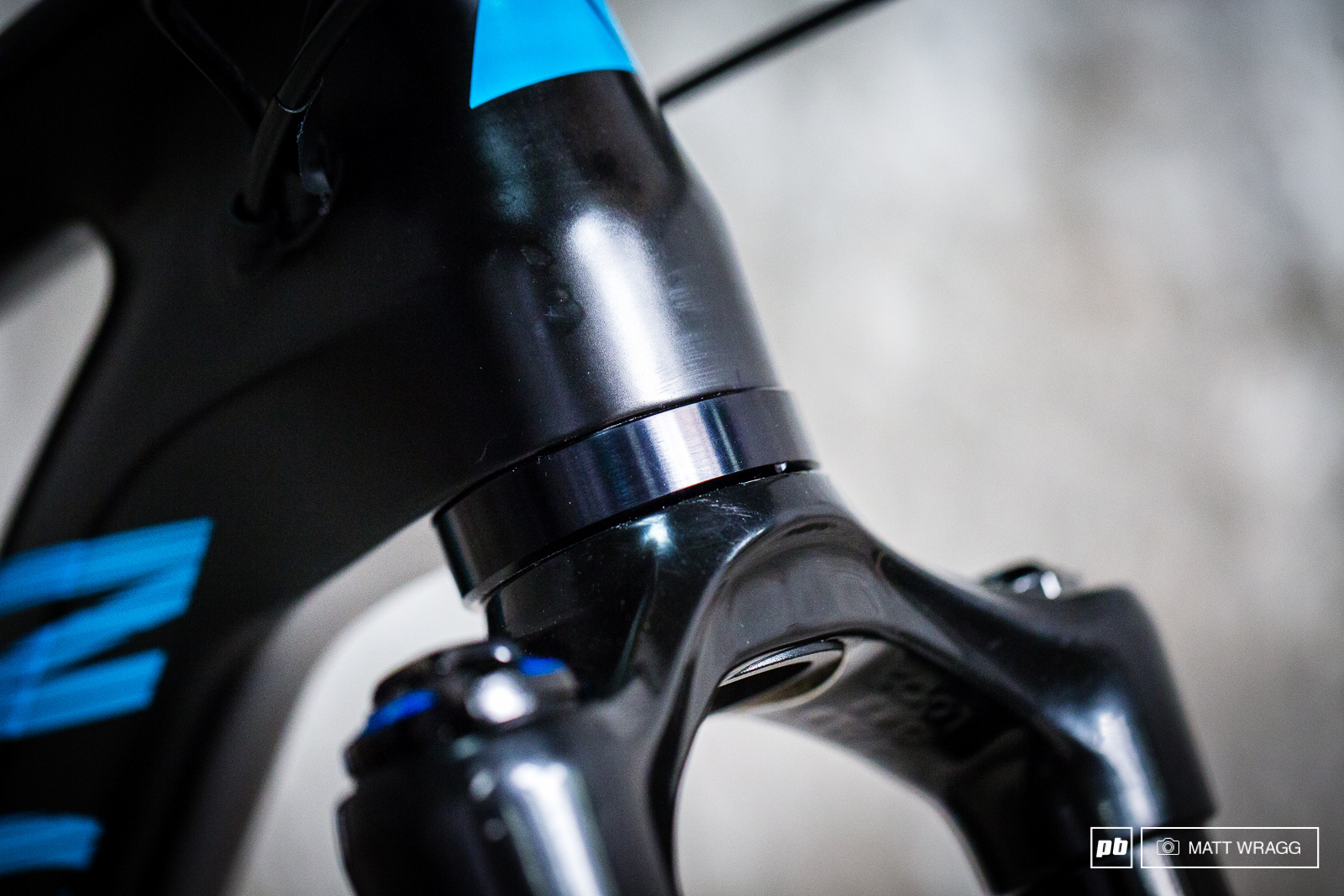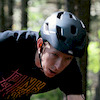To the casual observer, the bikes that Justin Leov and Joe Barnes will be racing at the final stop of the Enduro World Series look almost identical. Both riders will be aboard a Canyon Strive CF, the German company's flagship 160mm enduro race bike, and other than the fact the Leov is running a coil sprung shock, while Barnes has chosen air, the differences between the two bikes are difficult to spot at first glance. It's when you dive into the smaller details that things start to get interesting – the riding styles and physical size of Leov and Barnes have resulted in two completely unique race setups.
Overview
Justin Leov:
Justin Leov stands 6' (180 cm) tall and weighs 183 lb (83 kg), and is riding a size large Strive CF frame with a reach of 468mm. Leov prefers a longer bike due to the increased stability at speed, and usually runs a 40 or 50mm stem to achieve the ideal body position.
His days as a World Cup downhiller no doubt play a role in how he likes his bike to feel, although up until the middle of this season the Kiwi's bike setup more focused on carrying speed on the less-rough section of trail rather than on being able to charge at full speed into technical sections. “My strengths in the past years have been in the physical aspects, and that's how I set up my bikes – they've been fast bikes that are set up more for carrying speed and maybe not so capable in the technical sections,” said Leov.
After being forced to take a break and miss part of the race season due to glandular fever, Leov started to experiment at the Whistler EWS round, and is now on a machine that's closer to a downill bike than a trail bike. There's a coil sprung RockShox Vivid in the back, and a 180mm Lyrik up front. “For me it's been a little bit of a breakthrough. The bike sits in a much better position, I've got a little bit more rowdiness in me. If I'm in a race situation I can go off a drop or get loose in a section and it feels to me like I can recover from that more like I'm on a downhill bike, where in the past it's been more like I was a passenger in those sections,” said Leov.
Joe Barnes:
Joe Barnes checks in at 5'8” (173 cm) and weighs 150 lb (68 kg). He's riding a size small Strive CF frame with a reach of 422mm. There's been a push for longer bikes and shorter stems over the last few seasons, but Barnes hasn't completely bought into that trend; this season he actually downsized to a smaller frame size. He also prefers running a 50mm stem versus the 40 or 30mm options that have become popular, due to the slightly slower steering that it provides.
“I've never pushed into holes or compressions when I'm riding – I never developed that style. I try to skip over stuff, and when I race I don't push harder I just get more precise,” said Barnes. While Leov's bike is closer to a downhill bike, Barnes' precise and nimble riding style (as well as his lighter weight) means that his bike isn't quite as singlemindedly focused on plowing through the rougher sections of the trail.
Suspension Setup
This is Justin Leov's first year riding for RockShox, which means that he's had to figure out entirely new base settings for his shock and fork. At the beginning of the season he was on a Monarch Plus in the rear and a 170mm Lyrik up front, but he's since switched to Vivid coil and a 180mm Lyrik.
Depending on the course, Leov runs either 3.5 or 4 tokens inside his Lyrik, which creates the greatest amount of bottom out resistance possible. This allows him to have a fork that feels supple initially, but then still has plenty of support and stability once speeds increase. The overall feel between the front and rear suspension is balanced, although riders that aren't riding at a pro-level pace would likely find it to be very stiff.
There's a 550 lb spring on the shock, and it's been custom-tuned with increased compression damping to prevent Leov from going through the travel too quickly. Leov and his mechanic have been experimenting with different rebound settings, but with only one race remaining they haven't gotten too crazy – the more drastic experimentation will take place in the off-season.
Joe Barnes is running a 170mm Lyrik, but he's also using an angleset, which slackens the bike's head angle out the same amount that a 180mm fork would. There are three tokens in the Lyrik, and the rebound is set on the fast side compared to what would be considered “normal.” Out back, the Monarch Plus is set up with 30% sag, and it's equipped with a custom shim stack to provide a faster rebound speed at the beginning of the stroke and slower rebound at the end. Overall, it's not that extreme of a setup, partially due to Barnes' riding style. If you're popping and skimming over the tops of holes and compressions you don't need quite as much support compared to someone with a steamroller-like riding style.
Stem, Bars, and Brakes
There may be a four inch height difference between Justin Leov and Joe Barnes, but they're both running 740mm bars. Why? “There's so many stages we do that are through narrow trees, and if you ride a wide bar and have to cut it down for a race it feels unusual. If you're used to running a 740 or 750 bar you're used to it from course to course,” said Leov. But before you rush out to the garage with a hacksaw in a quest to gain EWS street cred, keep in mind that both riders ride with their hands hanging slightly over the outer edge of the bars, and the Ergon lock-on grips add about 5mm to each side.
The two riders also prefer low stem heights, although Barnes takes it the furthest, removing his head set top cap in order to get the stem absolutely as low as possible. It's a unique setup, especially considering that he's running a bar with 20mm of rise, but it's certainly not slowing him down.
If you were to walk around the pits grabbing the brakes of the pros in attendance at this weekend's race you'd find a wide range of settings. Lever angle, bite point – everyone has their own particular position that they prefer. Joe Barnes' lever bite point is on the extreme side of things – his brakes don't even engage until they're mere millimeters from the bar. “I have them really close in and then brake with the middle portion of my finger rather than the end... Everyone from Fort William runs them the way I do – we just never thought anything of it,” said Barnes.
Leov sets his brakes up with the bite point much farther out, and said, “I cannot ride a bike with the braking point close to the bar. If I have them there something feels completely off.” He's also switched to Code brakes in order to help fight the tendinitis that he's struggled with this season – the additional power means he doesn't need to grab onto the levers quite as hard.
Wheels and Tires
As enduro race courses become more and more technical, tire choice is becoming critical, and choosing the wrong tread pattern or casing can make the difference between standing on the podium or the sidelines. Leov says he can't get away with running tires that weigh less than 1100 grams, and for some races he uses a special insert, similar to what's used in the moto world, for increased pinch flat protection. Tire pressure ranges depending on the track, but the maximum he runs is 30 psi in the rear and 26 in the front. For slow speed, slippery tracks he'll drop as low as 22 psi up front.
Barnes is especially particular about his tire pressure, going as far as carrying a pressure guage with him on course and checking his pressure before every stage. “I always make sure that's the same and then I can trust my grip,” said Barnes. For this weekend he'll be running 21 psi up front and 26 psi in the rear, and will be using new tires from Mavic that have a prototype casing, one with a slightly stiffer sidewall for increased support.
Rim widths have been increasing over the last few seasons as well, and both riders said they've been enjoying the 28mm internal width on Mavic's new Deemax wheelset. They're still experimenting with different rear rim widths, and once the season concludes there's plenty of testing to be done to determine the optimum race rim width.
What's Best?
Justin Leov and Joe Barnes are extremely in tune with their bikes, but even though they can rattle off all sorts of geometry figures and shock pressures at the drop of a hat, their ideal setup is derived by feel. There's no magic formula that can be used to come up with a setup that works perfectly for everyone, and even the fastest riders in the world are constantly tweaking and refining their bikes in search of the ideal configuration, one that's comfortable and fast.
Want to learn even more? Listen to the full audio from Matt Wragg's interview:
Author Info:
Must Read This Week
How to Watch the 2024 Mountain Bike World Cup [Update: Staylive Offering Access in New Zealand, South Africa & More]
60519 views
60519 views
[UPDATED] Final Elite XC Results & Overall Standings from the Mairiporã XC World Cup 2024
41506 views
41506 views
Sign Up for the Pinkbike Newsletter - All the Biggest, Most Interesting Stories in your Inbox
PB Newsletter Signup













I think index finger braking is more common than middle finger braking. The only people I know who use middle finger braking are Emily Batty (XC racer), Steve Jones (UK Dirt Mag editor) and me. It could be worth considering though if you haven't tried it. Most people I rode with at the Megavalance Alpe d'Huez (which consists of some longer descends) had tired hands from braking so much. Exceptions were a lady running the powerful Magura Gustav M brake and me (braking with the middle finger). Of course many modern brakes provide high brake force comparable to good ol' Gustav. Though as people also typically run larger wheels (larger than 26") and smaller brake rotors (smaller than 210mm) I'm not so sure how that compares.
The second isn't really a problem for a racer who gets new pad & a brake bleed every few days on the outside, but for the rest of us, a setup where the lever is powerful enough right next to the bar, won't be after a period of time. air or water in the lines, brake pad wear, etc, all conspire to move the engagement point of brakes, when the system is left to its own ends for weeks or months.
Head tube length (especially with the angle set) looks ridiculous on Joe's bike. No doubt he has to run that bar but I bet he would rather have a lower stack.
Nino wouldn't use a 29" for years due to stack height even though he's now clearly even faster on the 29". Obviously stack height is more important for XC but still, Joe is hardly beer league is he?
Maybe they were out of stock when he removed the headset cover, or maybe he thinks it looks cool (which it doesn't).
FWIW, I noticed Atwill is running quite a high bar as well on his Spindrift.
Seems like Atwill is quite comfortable when cornering as well, with bars that seemto be even higher than mine..
I wish I could say the same.
Vivid with climb switch debut next year?
www.mtb-news.de/forum/attachments/img_0377-jpg.371564
static1.1.sqspcdn.com/static/f/1061829/25475241/1448598188650/12253722-23471710-thumbnail.jpg?token=csc7W%2BxXboN2cdP%2F01NsTcCZUfg%3D
Everyone! Get this @Marcusthefarkus guy on the phone with Leov and Barnes, he's got the answer to their problems!!
That sums up 90% of arguments on bike internet.
Also, the "If pros can run it, you can too" argument isn't the strongest.
In the climate where lots of people btch on plus tyres being for poor riders, E-bikes being for absolute lazy morons, maybe supporting long posts by not so tall people is load of hipocrisy? Because you want all that sht in there and then you whine of shocks being driven by a yoke, fkng up your bushings and shock shafts
END RANT
If we don't make droppers over 150mm, think of how we will be losing the gene for being over 6'4" due to all of the smashed testicles...who'll change all the light bulbs then?
Save the 6'8" testicles!
Its not just customers, I have seen journalists criticise the fitment of 150mm droppers on bikes stating they would prefer a 170mm - Quite strange to see.
@Pedro404 - yea mate, public demand justifies everything. Like E-Bikes.
From IMDB (spoiler alert) : "Bottom out" 2016 directed by Matthias Denison - A touching and shocking story of Angus Schwarzer, ranch owner and vivid downhill rider who crashed out on Crabapple bits after closing hours of Whistler Bike Park. He laid unconscious by the side of the track until an E-biker Daniel Heart riding up the trail found him lyting with cracked helmet and pants pulled down. He called for helicopter and in the hospital it appeared that Angus suffered a minor concussion and cracked butt. At first Angus thought he must have landed hard on his saddle, but during a party with his bros, he smoked marijuana at the back of his van and got a flashbacks of being repetively pushed into the ground while being unconscious. Another visit to the doctor showed clear signs of rape and hypnosis confirmed that. He decided to come out posting a story on Ride Monkey but he got laughed at. Broken, he decided to remain silent until 28 other victims reached him anonymously. All raped on Crabapple bits and A-Line after closing hours. 3 Perpetrators had been caught and put to trial. They owned a Black van with "F*CK Joey´s - Make Whistler great again" written on it. Group postulated for making all jumps on A-line into gaps filled with hungry black bears. Even though they got prosecuted his life was never the same. All DH friends turned away from Angus. Emptied of stoke, he finally reached out to his saviour, Daniel, and found new friends among E-bikers, building trails and promoting MTB access to the wilderness in United States.
Documentary has been awarded a "Shreddie" award on Reunion Fest in Squamish. Unique footage shot on GoBro 6S camera.
We don't need our seats slammed like a DJer, but not all of us have the same "XC"-esque style that Minnaar has (straighter legs, ass high, chest low). Before everyone jumps on me for calling Minnaar's style XC...I just can't think of a better way to describe it. Anyone who is a competent rider has their chest low, obviously...
It's certainly nice to use your saddle to control lean with the inside of your thigh, and, as such, many of us do it, but that extra 20mm of drop doesn't limit any bike control abilities. What it would do is give me that little bit of extra leg extension where I wouldn't have to manually drop/raise my post for the majority of my descents/climbs.
I don't really mind the hassle of raising/lowering my post as my trail network is far less "enduro" from the perspective that we typically have a long climb followed by a long descent (long is subjective as we obviously don't have a ton of vertical in socal). For some of the more varied single track I ride in the santa monica mountains, it would be great to gain that extra 20mm so I could have a slightly lower seat for the downs while still having my preferred leg extension; funnily enough, 20mm kind of feels like a lot of extra room even though it's less than an inch.
I decided to go for the 2016 model, already got a Fox Transfer 150mm and consider switching to Shimano brakes; I don't need Eagle since I come from XC and a 34t chainring makes me happy in any situation.
28+psi in the rear won't entirely prevent pinch flatting and/or blowing up wheels , but it certainly helps. My buddies and I can never figure out why so many people run such low pressures...there's a reason racers and competent riders don't.
I've only run E13 since I changed to 29" wheel and wide rim Halo 30m ID....I was looking at also running a Mary on the front and either a DHR2 or HR2 on the back for the winter...is this a bad idea?
I like the Ardent (I run 2.4 and 2.25 on a HT but it just aint tough enough for sharp/abrasive rocks IMO. The 2.4 is a big round tyre without much carcass strength and I can see how it would easily roll off on a 25mm ID rim particularly when executing a move.
*not sure slackness is a real word.
I guess running coil shock makes a lot of sense on a Strive with Shapeshifter, no need for climb switch at all.
Comparison review on 2 bikes , they list all the nitty gritty dimensions such as frame size , bar width , tokens in the fork , stem length and why for each yet no where mention the actual wheel size that the bike uses .
Thanks Mike with companies starting to offer the same model bike in 27.5", 27.5"+ and 29" one never knows if it,s not in bold numbers on the tire .
Lol.
There is an error in the description, S size frame looks different.
coresites-cdn.factorymedia.com/dirtde/wp-content/uploads/2014/10/20141001_CanyonStrive_3748.jpg
www.vitalmtb.com/features/Bike-vs-Bike-Brian-Lopes-Intense-Tracer-T275-vs-Intense-Carbine-29,1401
www.vitalmtb.com/features/Bike-vs-Bike-Wyn-Masters-GT-Fury-vs-Ed-Masters-Bergamont-Straitline,1360
www.vitalmtb.com/features/Bike-vs-Bike-Cam-Zinks-YT-TUES-vs-YT-TUES,1356
www.vitalmtb.com/features/Bike-vs-Bike-World-Champs-Edition-Custom-Intense-M16s-Jack-Moir-vs-Nik-Nestoroff,1449
www.vitalmtb.com/features/Bike-vs-Bike-Yoann-Barellis-Giant-Reign-or-Adam-Craigs-Giant-Trance,1322
www.vitalmtb.com/features/Bike-vs-Bike-Anneke-Beertens-GT-Force-or-GT-Sanction,1333
www.vitalmtb.com/features/Bike-vs-Bike-Vital-Member-Edition-Custom-Santa-Cruz-Syndicate-Nomads,1442
www.vitalmtb.com/forums/The-Hub,2/Bike-vs-Bike-Santa-Cruz-Bronsons-of-Iago-Garay-and-Mark-Scott,9036
www.vitalmtb.com/forums/The-Hub,2/Bike-vs-Bike-Peatys-V10-or-Brosnans-Demo-at-Lenzerheide,9321
So did we. Several months (years?) ago we thought that the small nuances between bikes/setups were fascinating, and brainstormed a way to capture that fascination and bike nerd-stoke in an article. The result of which was Bike vs. Bike - a feature we've run many times in the past year.
When I saw your piece pop up, the similarities between what you created and what we've previously published were too close to ignore:
- You pit one rider against another, specifically to talk about their respective bike setups
- The side-by-side photo layout carries a resemblance
- You embed an audio recording of a chat with the riders
- Even the name is oddly similar
I trust you can see where I'm coming from...
Just as you guys do, we bust our asses off over at Vital to create cool content. It can sting a little when others latch onto feature ideas, article topics, video formats, etc that we were the first to execute.
But then again, I suppose great minds do think alike. Let's just do it with some mutual respect.
Woah there guys! I thought I started this style of feature off last year?
www.pinkbike.com/u/paulaston/blog/whats-the-difference-nekos-vs-brendans-scott-gamblers.html
EnduroMag has been doing the same style of article for a while too.
enduro-mtb.com/en/pro-bike-check-comparing-richie-rudes-cody-kelleys-yeti-sb6c
I'm sure it's been done in the past years before our time – there's not many original ideas out there anymore...